

| The Avebury Stone Circle is at the center of a number of prehistoric ceremonial sites, burial mounds, and processional avenues, including West Kennet Avenue, Silbury Hill, West Kennet Long Barrow, and Windmill Hill. Stonehenge is about 20 miles south of Avebury. The Avebury Circle is one of the largest henges in Britain. (A henge is a ceremonial enclosure surrounded by a bank and ditch with at least one ceremonial entrance.) According to Caroline Malone, the total area of the Avebury Circle is about 28 ½ acres. The depth of the ditch was originally 21-30 feet (7-10 M) and the height of the bank was 18 feet (6.7 M) so that originally the total height could have been about 50 feet, from the base of the ditch to the bank crest(11). | ||
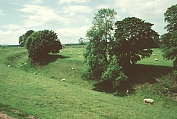 |
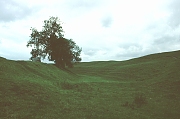 |
The ditch and bankThe site is on a natural chalk dome; originally the henge would have been a luminescent white. Some scholars speculate that the ditch was filled with water, thus giving the Circle a more dramatic focus. |
| Like Stonehenge and other Neolithic monuments, the Avebury site was altered during the two thousand years of its ritual use by Neolithic peoples. It consisted of a large circle of at least 98 stones (of which 27 still exist) and two smaller circles within the large circle (each about 340 feet in diameter and with perhaps 30 stones) where the main ceremonies probably occurred. Few stones remain in these inner circles. See this reconstruction drawing of the original site. | ||
The northwest sector of the outer circleUnlike the stones at Stonehenge, these are unworked stone. Varying from 9-19 feet high, they were quarried about two miles away. |
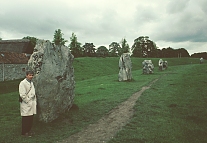 |
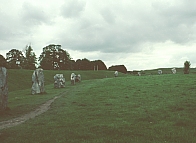 |
sm.jpg) |
 |
The Swindon StoneThe Swindon Stone, one of the largest stones (weighing about 65 tons), marks the north entrance. |
| Although Christians, eager to eradicate signs of paganism, had broken up some of the stones in the late Middle Ages, the main outlines of the site were still visible when the antiquarian John Aubrey "discovered" it in 1649. In the 17th and 18th centuries many of the original stones were split open (by lighting fires around them and pouring water on the heated stones). Thus many of the buildings (partly within the circle) were constructed of broken stones. Today concrete markers indicate where stones once stood. | ||
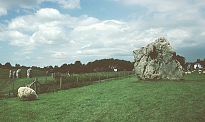 |
 |
The southwest sector |
The CoveThe ruined inner north circle had a three-sided focal point. Only two stones remain at the center--the so-called Cove, which has some of the largest stones. |
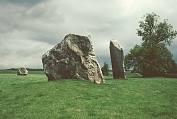 |
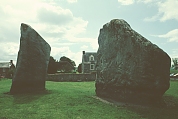 |
 Click here to return to places index.
Click here to return to places index.
 Click here to return to index of artists and architects.
Click here to return to index of artists and architects.
 Click here to return to chronological index.
Click here to return to chronological index.
